Three Initiatives for Balanced Regional Development
Three Initiatives for Balanced Regional Development*
December 9, 2014-February 23, 2017
I
The central leadership has decided to implement three initiatives: the Belt and Road Initiative, the Coordinated Development of Beijing, Tianjin and Hebei, and the Yangtze River Economic Belt. Their common feature is that they cross administrative divisions and promote balanced development between regions. I hope you will compare notes and reach consensus and carry them out, and strive for a good start next year. The Belt and Road Initiative offers good development opportunities to the eastern, central and western regions, and especially to some marginal areas in the west which will become centers with great development potential as soon as they are interconnected with neighboring countries. In the future, a key point of our policies on regional development will be to unify the large domestic market, which is both a problem to be addressed and an important challenge facing fiscal and taxation reforms. We should break regional barriers and vested interests through reform and innovation, so as to comprehensively improve the efficiency of resource allocation.
(from the speech at the Central Conference on Economic Work,
December 9, 2014)
II
To promote the development of the Yangtze River Economic Belt, a leadership system and a working mechanism must be established to coordinate, plan, guide and carry out all the work. The National Leading Group for the Development of the Yangtze River Economic Belt should bear in mind the general picture and be realistic, while serving as a guide and a supervisor. Our clear direction and focus is to protect the ecological environment, establish a unified market, and speed up transformation of the growth model and structural adjustment, for which we should be quick-minded and provide more services. To make scientific use of water resources, optimize the industrial configuration, coordinate port and shoreline resources, and arrange major investment projects, we should consider carefully and sometimes give up certain projects if we cannot see the optimal approach or reach immediate agreement. When choosing from two or more options, we need to compare them, choose the best option, and test the choice as appropriate. We need to make a negative list of all those things that are not feasible. Market forces and openness are two important drivers for the development of the belt. The market should play a decisive role in resource allocation, while the government plays its own role more effectively. Governments of provinces and municipalities along the river should accelerate the transformation of their functions, provide better public services, and create a favorable market environment. Provinces and municipalities along the river and relevant state departments should reach consensus and make concerted efforts to build a golden belt with a more beautiful ecology, smoother traffic, a more coordinated economy, a more unified market, and a sounder mechanism.
(from the speech at the Forum on the Development of the Yangtze
River Economic Belt, January 5, 2016)
III
In planning and building the Xiong'an New Area [part of the Beijing-Tianjin-Hebei coordinated development program], under the leadership of the CPC Central Committee we should follow the underlying principle of seeking progress while maintaining stability, and reinforcing and implementing the new development concepts. We should adapt to, keep good control of, and steer the new normal in economic development so as to push forward supply-side structural reform, and adopt a global vision, international standards, Chinese characteristics, and high goals. The area should prioritize ecological protection and the needs of the people, ensure and improve public wellbeing, and protect and carry forward the traditional culture of China, aiming to become an eco-friendly and livable urban area, and a demonstration area for innovation-driven, coordinated and open development. We should strive to transform Xiong'an into an innovation demonstration area guided by the new development concepts.
There are seven major tasks to be completed in the Xiong'an New Area:
1. Building a world-class, green, modern and smart city;
2. Building an eco-city with a scenic environment, blue skies, fresh air and clean water;
3. Developing high-tech industries, attracting innovative factors and resources, and fostering new drivers for growth;
4. Offering quality public services and infrastructure, and creating a new urban management model;
5. Establishing a fast, effective and green transport network;
6. Pushing for structural and institutional reforms, letting the market play a decisive role in allocating resources, and ensuring that the government fulfils its functions in a better way so as to stimulate market vitality; and
7. Opening wider to the world and creating a new platform for international cooperation.
(from the speech on the planning and building of the Xiong'an New
Area, February 23, 2017)
* Excerpts from speeches made between December 9, 2014 and February 23, 2017.
(Not to be republished for any commercial or other purposes.)



